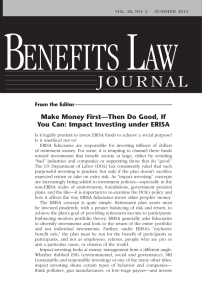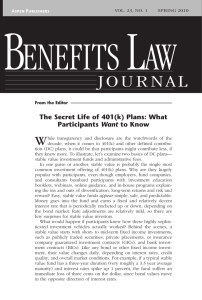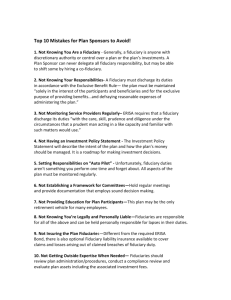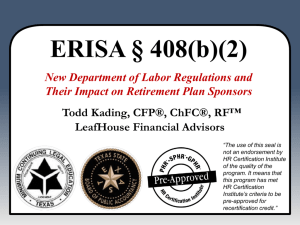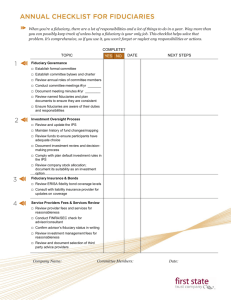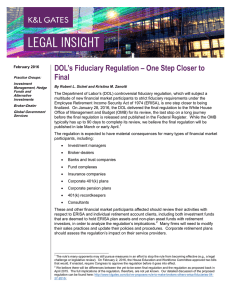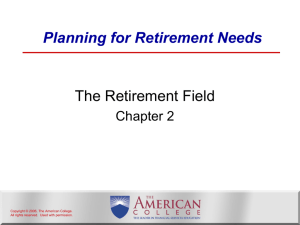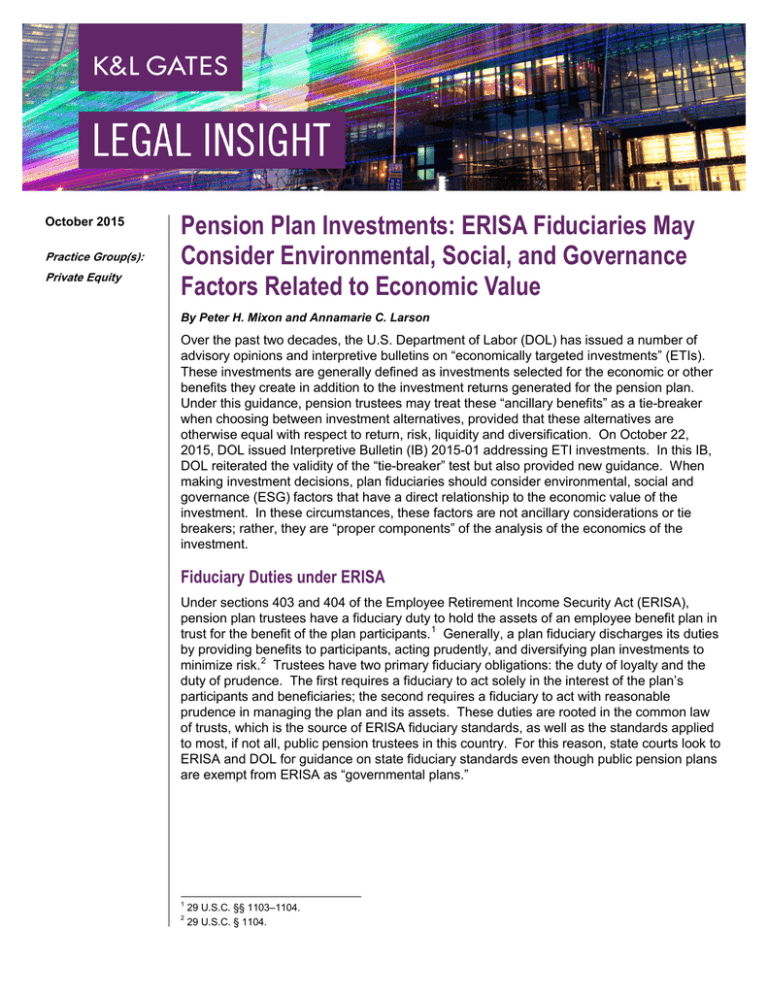
October 2015
Practice Group(s):
Private Equity
Pension Plan Investments: ERISA Fiduciaries May
Consider Environmental, Social, and Governance
Factors Related to Economic Value
By Peter H. Mixon and Annamarie C. Larson
Over the past two decades, the U.S. Department of Labor (DOL) has issued a number of
advisory opinions and interpretive bulletins on “economically targeted investments” (ETIs).
These investments are generally defined as investments selected for the economic or other
benefits they create in addition to the investment returns generated for the pension plan.
Under this guidance, pension trustees may treat these “ancillary benefits” as a tie-breaker
when choosing between investment alternatives, provided that these alternatives are
otherwise equal with respect to return, risk, liquidity and diversification. On October 22,
2015, DOL issued Interpretive Bulletin (IB) 2015-01 addressing ETI investments. In this IB,
DOL reiterated the validity of the “tie-breaker” test but also provided new guidance. When
making investment decisions, plan fiduciaries should consider environmental, social and
governance (ESG) factors that have a direct relationship to the economic value of the
investment. In these circumstances, these factors are not ancillary considerations or tie
breakers; rather, they are “proper components” of the analysis of the economics of the
investment.
Fiduciary Duties under ERISA
Under sections 403 and 404 of the Employee Retirement Income Security Act (ERISA),
pension plan trustees have a fiduciary duty to hold the assets of an employee benefit plan in
trust for the benefit of the plan participants. 1 Generally, a plan fiduciary discharges its duties
by providing benefits to participants, acting prudently, and diversifying plan investments to
minimize risk. 2 Trustees have two primary fiduciary obligations: the duty of loyalty and the
duty of prudence. The first requires a fiduciary to act solely in the interest of the plan’s
participants and beneficiaries; the second requires a fiduciary to act with reasonable
prudence in managing the plan and its assets. These duties are rooted in the common law
of trusts, which is the source of ERISA fiduciary standards, as well as the standards applied
to most, if not all, public pension trustees in this country. For this reason, state courts look to
ERISA and DOL for guidance on state fiduciary standards even though public pension plans
are exempt from ERISA as “governmental plans.”
1
2
29 U.S.C. §§ 1103–1104.
29 U.S.C. § 1104.
Pension Plan Investments: ERISA Fiduciaries May Consider Environmental,
Social, and Governance Factors Related to Economic Value
Previous DOL Bulletins
In 1994, the DOL issued IB 94-1 to address the issue of ETIs. In the summary section, the
DOL explained that plan fiduciaries could invest in an ETI “if the ETI has an expected rate of
return that is commensurate to rates of return of alternative investments with similar risk
characteristics that are available to the plan, and if the ETI is otherwise an appropriate
investment for the plan in terms of such factors as diversification and the investment policy of
the plan.” 3 This has been called the “all things being equal” test. DOL reasoned that by
using this test the economic interests of the plan beneficiaries are protected if the selected
investment is economically equivalent to competing investments. Thus, if an ETI had a
similar rate of return and risk characteristics as an alternative investment, the plan fiduciary
could choose the ETI using ESG (or similar) factors as the “tie breaker.”
In 2008, the DOL superseded IB 94-1 with IB 08-01, clarifying that “fiduciaries who rely on
factors outside the economic interests of the plan in making investment choices … will rarely
be able to demonstrate compliance with ERISA absent a written record demonstrating that a
contemporaneous economic analysis showed that the investment alternatives were of equal
value.” 4 The IB listed several examples of when ETIs were not proper alternatives — when
they created risk of large losses, when they lacked diversification or when they did not allow
the plan to meet liquidity needs. IB 08-01 effectively required additional due diligence if
fiduciaries relied on any collateral factors to influence investment decisions. Thus, DOL
appeared to be dissuading plan fiduciaries from making ETIs and from considering similar
factors in making investments.
Guidance from IB 2015-01
Because DOL believes the previous IB “unduly discouraged fiduciaries from considering
ETIs and ESG factors,” the DOL this month withdrew IB 2008-01 and replaced it with IB
2015-01. 5 Under the new IB, DOL articulated four important points of guidance.
First, DOL restated its long-standing “tie-breaker” rule. Pension trustees do not violate their
fiduciary duties when making ETIs, provided that the investment is economically equivalent
to alternatives. Under this analysis, collateral factors may be used as tie-breakers when
choosing between investment alternatives that are otherwise equal with respect to risk
characteristics and rate of return.
Second, DOL clarified that fiduciaries may also view ESG factors as central factors in the
economic analysis of competing investments and not as simple tie-breakers. As DOL
explained, “[e]nvironmental, social, and governance issues may have a direct relationship to
the economic value of the plan’s investment. In these instances, such issues are not merely
collateral considerations or tie-breakers, but rather are proper components of the fiduciary’s
primary analysis of the economic merits of competing investment choices.” 6 Thus,
3
IB 94-1.
IB 08-01 (emphasis added).
5
IB 2015-01.
6
Id. (emphasis added).
4
2
Pension Plan Investments: ERISA Fiduciaries May Consider Environmental,
Social, and Governance Factors Related to Economic Value
“[f]iduciaries need not treat commercially reasonable investments as inherently suspect …
merely because they take into consideration environmental, social, or other such factors.” 7
Third, ERISA plans may incorporate ETIs in their investment policies. The DOL clarified that
ERISA does not prohibit a fiduciary from “addressing ETIs or incorporating ESG factors in
investment policy statements or integrating ESG-related tools, metrics and analyses.”
Finally, DOL provided guidance that there is no requirement for special documentation or
evaluation of ETIs beyond that required for other investments. The standards applicable to
ETIs are no different than the standards applicable to plan investments generally: “the
Department believes that fiduciaries responsible for investing plan assets should maintain
records sufficient to demonstrate compliance with ERISA’s fiduciary provisions. As with any
other investments, the appropriate level of documentation would depend on the facts and
circumstances.” 8
Conclusion
This new IB is a significant milestone that recognizes the value of environmental, social and
governance factors in investing. So long as these factors are “directly related” to the risk,
return and liquidity profiles of an investment, plan trustees may appropriately integrate them
into the decision making process without compromising their fiduciary duties of loyalty and
prudence. These factors are clearly related to many types of investments: The decision to
invest in the development of a new deep-water port, for example, should clearly include ESG
factors; for securities traded in an efficient public market, the correlation may not be as
readily apparent. But even for these investments, DOL has made clear that ESG analytical
tools are appropriate so long as they are reasonably prudent. Plan fiduciaries should,
therefore, become more comfortable with ETIs and ESG factors following this guidance.
7
8
Id.
Id.
3
Pension Plan Investments: ERISA Fiduciaries May Consider Environmental,
Social, and Governance Factors Related to Economic Value
Authors:
Peter H. Mixon
Peter.Mixon@klgates.com
+1. 206.370.7802
Annamarie C. Larson
Annamarie.Larson@klgates.com
+1. 206.370.8013
Anchorage Austin Beijing Berlin Boston Brisbane Brussels Charleston Charlotte Chicago Dallas Doha Dubai Fort Worth Frankfurt
Harrisburg Hong Kong Houston London Los Angeles Melbourne Miami Milan Moscow Newark New York Orange County Palo Alto Paris
Perth Pittsburgh Portland Raleigh Research Triangle Park San Francisco São Paulo Seattle Seoul Shanghai Singapore Spokane
Sydney Taipei Tokyo Warsaw Washington, D.C. Wilmington
K&L Gates comprises more than 2,000 lawyers globally who practice in fully integrated offices located on five
continents. The firm represents leading multinational corporations, growth and middle-market companies, capital
markets participants and entrepreneurs in every major industry group as well as public sector entities, educational
institutions, philanthropic organizations and individuals. For more information about K&L Gates or its locations,
practices and registrations, visit www.klgates.com.
This publication is for informational purposes and does not contain or convey legal advice. The information herein should not be used or relied upon in
regard to any particular facts or circumstances without first consulting a lawyer.
© 2015 K&L Gates LLP. All Rights Reserved.
4

